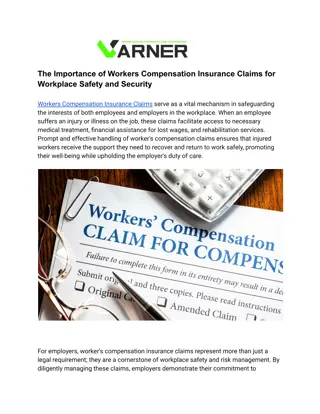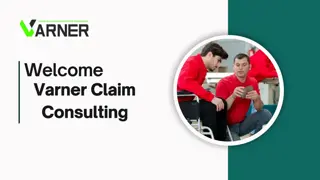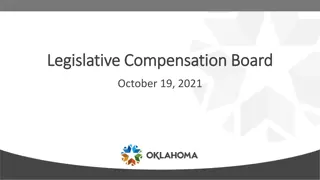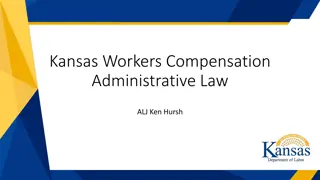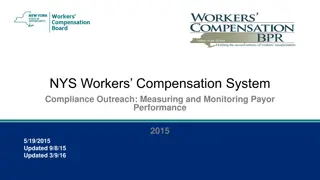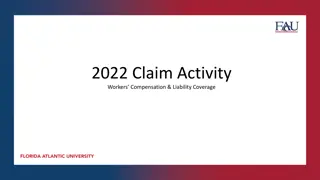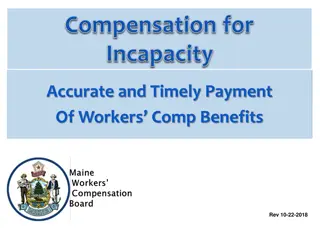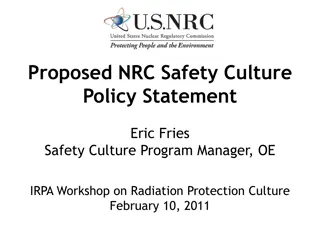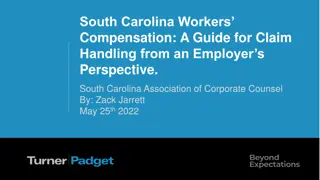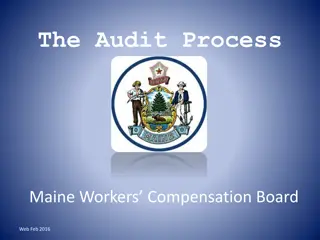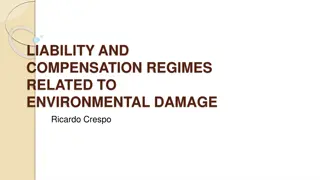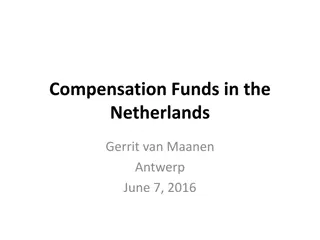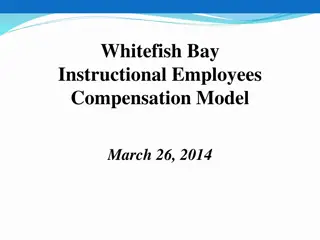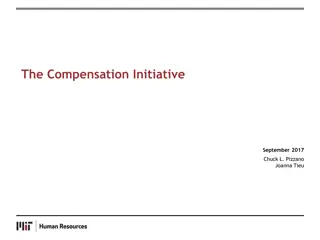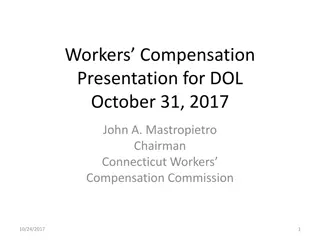Workers' Compensation and Safety Culture Training Overview
This training session delves into the importance of Workers' Compensation, the authority for health and safety in the workplace, components of a safety culture, benefits of fostering a safety culture, costs associated with Workers' Compensation, and the basics of Workers' Compensation including definitions, benefits, and eligibility. The course objectives cover essential basics, roles of supervisors and employees, and available resources for handling Workers' Compensation effectively.
Download Presentation

Please find below an Image/Link to download the presentation.
The content on the website is provided AS IS for your information and personal use only. It may not be sold, licensed, or shared on other websites without obtaining consent from the author. Download presentation by click this link. If you encounter any issues during the download, it is possible that the publisher has removed the file from their server.
E N D
Presentation Transcript
Workers Compensation Supervisor Training Presented By Chris Heilgeist HR Assistant/WC Coordinator Human Resources Bob Grieshaber Risk Management Officer Safety & Risk Management
Authority for Health & Safety Under state law, employers have a duty to provide safe employment, which includes having a safe place to work and free of recognized hazards. UW System institutions are responsible for the maintenance of environmental, occupational health and safety standards and for the promotion of workplace health and safety and environmental quality. OSHA Regulations: 29 CFR 1910 and 1926 Wisconsin State Statutes University of Wisconsin System Policies State of Wisconsin Executive Orders Campus and UW Policies, Practices and Guidelines
Components of a Safety Culture Communicate campus and departmental values Demonstrate leadership at all levels, safety coaching concept Clarify required and expected behavior Personalize safety outcomes Develop positive safety attitudes including open dialogue Engage and own safety responsibilities and accountabilities Increase hazard & risk awareness, and preventive behaviors Improve understanding and effective implementation of safety and risk management systems Use positive reinforcement Monitor, review and reflect on personal and organizational effectiveness Adequate funding, support and professional development Source: Workplace Health and Safety Queensland, and Robert Grieshaber
Benefits of a Safety Culture Reduced incidents/injuries Increased productivity Reduced costs Reduced turnover
Cost of Workers Compensation Lost time Medical reimbursement Reduced productivity Turnover
Course Objectives Worker s Compensation basics Supervisor s role Employee s role Resources
Workers Compensation BASICS
Workers Compensation Basics Definition Benefit program Loss of wages Medical and hospital expenses Restore work capacity Covers work-related injuries or illnesses Eligibility Employee of University of Wisconsin-Parkside Work-related injury/illness
Workers Compensation ROLES AND RESPONSIBILITIES
Workers Compensation Roles Supervisor Safety & Risk Manager HR Employee Coordinator UW System Claims Examiner
Employees Role Report Incident Seek medical attention if needed Complete Form(s) Time Sensitive Tasks
Employees Role Communicate with HR/Supervisor Share WC contact information with Provider Accept restricted duty/honor restrictions Report Time/Absences Ongoing Tasks
Supervisors Role Assist Employee Notify HR & Safety & Risk Mgr Investigate Complete/submit forms Time Sensitive Tasks
INVESTIGATE Incident Categories: The causes of any incident can be grouped into five categories, and each should be investigated. Source: Canadian Centre for Occupational Health & Safety
Ask Who What When Why Where How PPE INVESTIGATE Emphasis to find the root cause Prevent future incidents (i.e., how can this be avoided in the future?) Find the facts that lead to corrective action Reinforce positive behavior & expected behavior Reduce lost time Emphasis on early return to work
Supervisors Role Communicate with HR/Employee Coordinate Return to Work Review/Approve Time/Absences Maintain confidentiality Maintain a culture of safety Ongoing Tasks
Workers Compensation RESOURCES
Safety & Risk Manager Bob Grieshaber Ext. 2262 WC Coordinator Chris Heilgeist Ext. 2220 Campus Police Non-emergency ext. 2455 Emergency ext. 2911 Others? Resources People
Resources Forms Roles/Responsibilities UW System Office of Risk Management Electronic
Resources -Forms https://www.uwp.edu/explore/offices/humanresources/all-forms.cfm
Resources - Forms https://www.uwp.edu/explore/offices/humanresources/workers-comp.cfm
Resources Roles & Responsibilities https://www.uwp.edu/explore/offices/humanresources/illness.cfm
Resources UW System ORM Worker s Compensation Site https://www.wisconsin.edu/workers-compensation/
Resources Laws, Regulations, Policy and Practices OSHA 29 CFR 1910 and 1926 https://www.osha.gov/ Wisconsin Statutes 101.055 Public Employee Safety and Health http://docs.legis.wisconsin.gov/statutes/statutes/101/I/055 Wisconsin Statutes 101.11 Employer's duty to furnish safe employment and place http://docs.legis.wisconsin.gov/statutes/statutes/101/I/11 University of Wisconsin System UPS Operational Policy: GEN 11 https://www.wisconsin.edu/ohrwd/download/policies/ops/gen11.pdf State of Wisconsin Executive Order 194 for workplace safety (July 1993) https://walker.wi.gov/sites/default/files/executive-orders/EO_2016_194.pdf Campus and UW Policies, Practices and Guidelines https://www.uwp.edu/explore/offices/governance/policy67.cfm https://www.uwp.edu/explore/offices/humanresources/illness.cfm .
Workers Compensation EXERCISES AND SCENARIOS
ASSIST Review the Form for Missing, Vague, or Incomplete answers
Ask Who What When Why Where How Was PPE issued and worn? INVESTIGATE Emphasis to find the root cause Prevent future incidents (i.e., how can this be avoided in the future?) Find the facts that lead to corrective action Reinforce positive behavior & expected behavior Reduce lost time Emphasis on early return to work Seek to understand - not place blame
Report Phone or email details of incident Complete Packet: Employee s Work Injury & Illness Report Supervisor Accident Analysis & Prevention Report Repetitive Motion or Material Handling Supervisor Questions
Scenario 1 Overheard team conversation Yeah. Those stairs are an accident waiting to happen. Joe fell on them just last month. Joe is on your team and this is the first you heard of this fall.
Scenario 2 Employee reports that while stripping the floor two days ago, chemical splashed on his foot. He shows you a nasty chemical burn which has not yet been treated. Why didn t you report your injury? I didn t think it was serious.
Scenario 3 You learn that an employee you supervise tumbled down some snow-covered stairs on her way to a meeting in another building. When you arrive on the scene, the employee, looking pale, is sitting on the stairs and appears to be somewhat confused about the fall. Do you have someone who can pick you up and drive you to Urgent Care? No, I live alone.
Scenario 4 PROPER LIFTING TECHNIQUE An employee on your team was lifting a heavy box to move to another room when he felt a pop in his back. When you asked him to describe the incident, he described incorrect lifting technique, something you had coached him on in the past and on which he received formal training.





